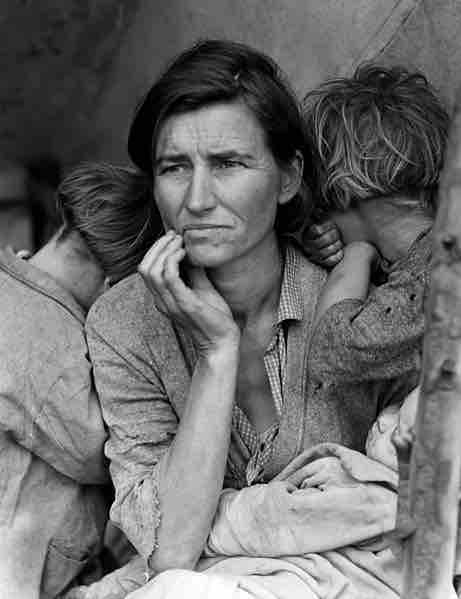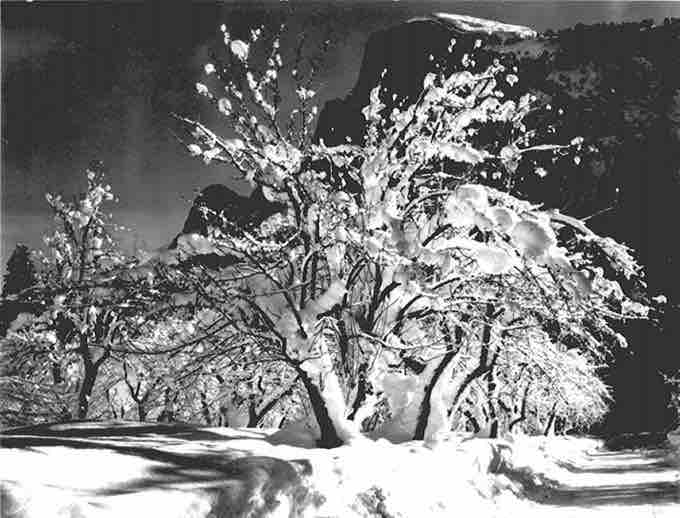The period from 1930-1945 in American history is marked by the Great Depression and outbreak of the second World War. During this time, both photography and sculpture expanded into new realms of artistic expression, heavily influenced by the society and times.
Photography
Photographic technology continued to expand throughout the 20th century. Kodachrome, the first modern "integral tripack" (or "monopack") color film, was introduced by Kodak in 1935, and Agfa's similarly structured Agfacolor Neu was introduced in 1936. These new technologies allowed for the proliferation of color photography for the first time, and currently available color films still employ a multilayer emulsion and the same principles, most closely resembling Agfa's product.
Social Realism
Social realism, also known as socio-realism, became an important art movement during the Great Depression in the 1930s. Social realism depicted social and racial injustice, and economic hardship through unvarnished pictures of life's struggles, often depicting working-class activities as heroic. The movement was largely a style of painting that typically conveyed a message of social or political protest edged with satire; however it also extended to the art of photography. Prominent photographers at the time included Walker Evans, Dorothea Lange , Margaret Bourke-White, Lewis Hine, Edward Steichen, Gordon Parks, Arthur Rothstein, Marion Post Wolcott, Doris Ulmann, Berenice Abbott, Aaron Siskind, and Russell Lee, among several others. Each of these artists sought to depict the world–and often the poverty–they saw around them with the realistic portrayal that only photography could provide.
The FSA
The Farm Security Administration, part of the New Deal, was an effort during the Depression to combat American rural poverty. The majority of the program was directed towards rural rehabilitation, but it is also known for funding the work of a number of photographers. From 1935-1944, the Farm Security Administration employed several photographers to document the effects of the Great Depression on the population of America. The Information Division of the FSA was responsible for providing educational materials and press information to the public. Under Roy Stryker, the Information Division of the FSA adopted a goal of "introducing America to Americans." Many of the most famous Depression-era photographers were fostered by the FSA project such as Walker Evans, Dorothea Lange, and Gordon Parks.

Dorothea Lange, Migrant Mother, 1936. A portrait of Florence Owens Thompson (1903-1983).
The caption of the image reads: "Destitute pea pickers in California. Mother of seven children. Age thirty-two. Nipomo, California. " Lange's image of a supposed migrant pea picker, Florence Owens Thompson, and her family has become an icon of resilience in the face of adversity.
Group F/64
Alongside social realism, another approach to photography referred to as "straight photography" was also gaining momentum. Group f/64 is perhaps the most well known example of this art movement. Group f/64 was a group of seven 20th century San Francisco photographers who shared a common photographic style characterized by sharp-focused and carefully framed images seen through a particularly Western viewpoint. In part, they formed in opposition to the pictorialism movement in photography that had dominated much of the early 20th century, but moreover they wanted to promote a new modernist aesthetic that was based on precisely exposed images of natural forms and found objects. Photographers involved in the group included Ansel Adams , Imogen Cunningham, John Paul Edwards, Sonya Noskowiak, Henry Swift, Willard Van Dyke, and Edward Weston.

Ansel Adams: Half Dome, Apple Orchard, Yosemite trees with snow on branches, April 1933.
Ansel Adams was one of the co-founders of Group f/64, a group of photographers known who shared a common style characterized by sharp-focused and carefully framed images.